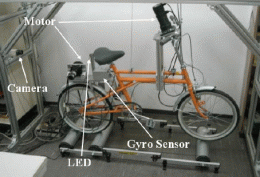November 4, 2008 feature
Engineers design self-stabilizing electric bicycle

(PhysOrg.com) -- As every five-year-old knows, balancing on a bicycle is not as easy as it looks. But, as engineers know, getting a bicycle to balance by itself – without a human riding it – is even more difficult.
Despite the challenge, engineers from Keio University in Yokohama, Japan, are developing a self-stabilizing electric bicycle, one that can stay upright by itself while being propelled and steered by electric motors. Their ultimate goal is to create a sophisticated, high-performance bicycle that could serve as a convenient alternative to a small car.
Yasuhito Tanaka and Toshiyuki Murakami, both with the Department of System Design Engineering at Keio University, will publish their study in an upcoming issue of IEEE Transactions on Industrial Electronics.
“The bicycle is a comfortable vehicle that is safe and can offer more familiarity with nature compared with the car,” Murakami told PhysOrg.com. “Especially, the bicycle is a convenient vehicle that can be useful as an activity for elderly people. However, it is thought that a lot of bicycle falling accidents occur with elderly people, and it is very useful to achieve a safer bicycle.”
As the first step toward their goal, the researchers designed an electric bicycle that maintains its balance and follows a straight path. In simulations and experiments, they tested three different strategies that combine stability control and trajectory control. The researchers found that a combination of the “posture controller” (for stability) and “steering function controller” (for trajectory) could enable the bicycle to drive by itself continuously.
In the experimental set-up, a conventional bicycle was placed on three rollers – two underneath the rear wheel and one underneath the front wheel. When the rear rollers rotated, the front roller rotated through a wire. Two motors controlled the motion of the bicycle – the motor on the handlebars controlled steering, and the motor in the back drove the rear wheel at an average speed of 2.5 meters per second.
To monitor the bicycle’s position and stability, the engineers attached an LED to the back side of the bicycle, and used a camera mounted behind the bike to monitor the LED’s movement. A gyro sensor attached to the bicycle also detected changes in the bicycle’s direction angle.
The researchers could control the bicycle in real time using feedback from these sensors with an RTLinux operating system. As the researchers explained, adjustments to the acceleration (back motor) and steering (front motor) were straightforward because the feedback could be interpreted to have a clear physical meaning. The control system then calculated the necessary motor adjustments.
“Because the posture response of the bicycle is passive, it is not possible to control directly,” Murakami explained. “Therefore, it is necessary to do the stabilization control indirectly by using the bicycle steering control. This is one reason why bicycle stabilization becomes difficult.”
While the optimal stabilization strategy allowed the bicycle to run on a straight path on the rollers, the other strategies could stabilize the bike’s posture, but had position errors that resulted in the bicycle diverging from its straight path.
One key to achieving these results was developing a simplified dynamic model for a bicycle, a modification of the more complicated but widely studied Sharp dynamic model developed by R. S. Sharp in 1971. The researchers’ simplified version enabled them to develop a bicycle controller that fused stability and trajectory control. While these experiments tested the bicycle’s ability to ride in a straight line, the researchers predict that the control strategy could also extend to curved trajectories.
The team plans to make improvements to the model to account for road irregularities and tire characteristics, which weren’t accounted for in this study. By confirming the feasibility of bicycle stability unassisted by a human rider, the researchers hope to continue making bicycles increasingly sophisticated and safe.
“Our final goal is to stabilize the bicycle at zero speed,” Murakami said. “Many bicycle falling accidents happen when elderly people stop a bicycle in a crosswalk, and so on.”
More information: Tanaka, Yasuhito, and Murakami, Toshiyuki. “A Study on Straight Line Tracking and Posture Control in Electric Bicycle.” IEEE Transaction on Industrial Electronics. To be published.
Copyright 2008 PhysOrg.com.
All rights reserved. This material may not be published, broadcast, rewritten or redistributed in whole or part without the express written permission of PhysOrg.com.





















